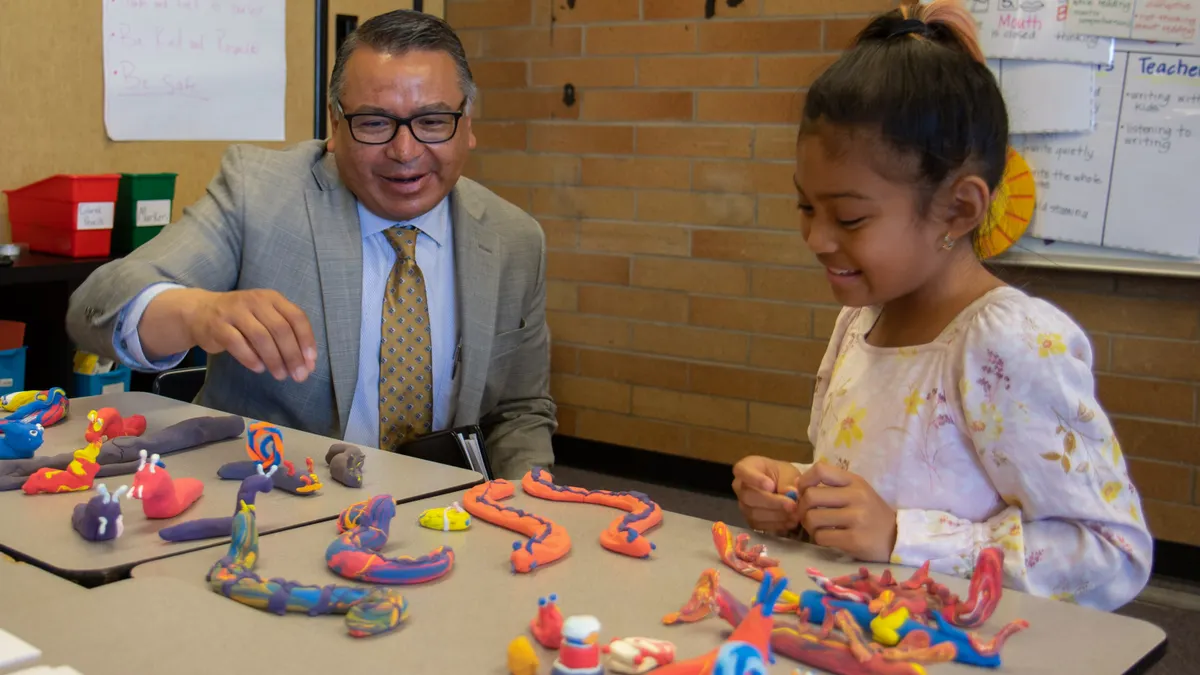With no shortage of tech finding its way into classrooms these days, there's a laundry list of questions administrators must deal with surrounding the best approaches for implementation, what to avoid, student data privacy, professional development, and more. As such, the U.S Department of Education has an office dedicated to assisting with just that.
As director of the department's Office of Educational Technology, Richard Culatta sees no shortage of things best avoided. But he also sees plenty of innovation to be excited about, from advancements in truly personalized learning to the use of games to assess student progress. And to help all districts gain access to what works best, the department announced at ISTE a new resource collecting success stories from schools and districts nationwide. Education Dive caught up with Culatta ahead of the show to discuss the new "story engine," what doesn't work in ed tech, and the department's presence at the year's biggest gaming trade show, the Electronic Entertainment Expo.
EDUCATION DIVE: What's on your radar at ISTE this year?
RICHARD CULATTA: A couple of things. We’re really interested in looking at how we can use technology to advance personalized learning. I’m really excited about that. For a long time, we’ve talked about doing personalized learning. It’s taken a while for the technology to catch up to the point that it’s useful, so that’s one area that I’ll be interested to see now that some schools are really doing it.
The other thing is — actually, this may be a little self-serving — but we’re actually going to be launching what we’re calling our “story engine” at ISTE. It’s just a sort of a database, if you will— a tool — that has a whole collection of stories of innovations from schools across the country that are using technology to transform learning. So we’re excited about both being able to share that at ISTE, and also to be able to just collect more — we’re going to have an open call at ISTE for people to share examples of really awesome things they’re doing — to transform learning through technology.
Can you tell me a little bit more about the story engine and how that came about?
CULATTA: Sure. I’ll tell you what happened is when we were trying to give examples when working with leaders and with teachers, one of the things we heard over and over again is, “What does this look like?” They always wanted to see it in practice and hear what other people had done. It seemed like there were some amazing things that were happening in schools. One of the great parts of my job is I get to see schools all over the country and just see some amazing things that school leaders and teachers and parents and students are doing. And it was fascinating to me how little other people knew about those stories. There’s one case in particular at a district where I went and visited that was just doing some amazing things in Arizona. And then, literally across the street, there’s the other district that was starting, and they didn’t have any of these innovations going on. They weren’t sharing them.
So we came back, and one of the things we decided at the Department of Ed that we needed to do was just help do a better job of sharing and highlighting schools and districts that are doing great things that nobody knows about — or certainly they don’t know about as much as they should. So that’s what launched work on the story engine, and we hope that over time it will really be a tool that will be very helpful to see not just what some school is doing across the country, but a school in your area, in your state, doing similar things that you’re trying to do and what sort of successes they’ve had.
Some argue that as much as tech can help classrooms, there’s also concern over the wrong approaches being taken, not enough training being offered, or data security. What’s the Education Department doing in part to mitigate those concerns?
CULATTA: Yeah. As I’m sure you can imagine, we have a lot of concern about watching out for what we don’t want to have happen. There’s actually a couple different ways where things can go wrong. One of them is obviously the security and privacy issue, which you talked about. And a couple parts on that: We have a chief privacy officer who really works on those issues. We’ve actually created a one-stop shop, if you will, privacy hotline for districts, for schools — even for technology developers. There’s a tool somebody’s building where they can call and it’s sort of an advice line to help make sure people not only are complying with the law, which is sort of a minimum, but also just best practice in the field around privacy.
The other piece about privacy to remember is we’ve found that when teachers and parents and students understand how the data is being used and who’s using it, they’re actually really open and willing — and in some cases, really excited about the benefits of what can be done with their data for personalized learning, to have a better sense of what their kid is doing in school and where they need help, all of that stuff. Where parents get really frustrated — and they should — is when there’s question marks, when it’s not transparent who’s using their data and for what purposes. So a lot of what we do is we work to just encourage schools to be transparent and make it clear. There’s some districts now — Chesterfield in Virginia, and Houston — that have posted publicly all of their terms of service agreements so anybody can go and look and see who’s allowed to use their data. So that all falls into the privacy bucket.
But there are other things to, and I’ll just give one other example — I don’t mean to go on and on here. I think one of the things that is the biggest sort of red flag for me is when schools are using technology in ways that simply digitize traditional practice. So an example of that would be, you know, instead of writing on a chalkboard, you have an electronic whiteboard and you do the exact same activity. The teacher’s standing up there writing on it just as they would, just in a digital form. Or maybe one that’s even more common is you’ve switched to using devices, and instead of having textbooks, the school switches to digital textbooks, so instead of looking at the textbook on a piece of paper, you’re essentially just looking at the textbook on a screen. That does not move our country ahead the way we need it to, and that does not close equity gaps for students across the country.
So that’s my other area, and sort of a warning. We need to be using technology to really transform learning, to really turn students into creators and give them the tools to design and invent and engage and not just do digital worksheets.
On that front, there’s traction building around rethinking assessments — particularly using games. The department recently hosted a mini-conference at the Electronic Entertainment Expo, so what are some of the big developments that came out of that?
CULATTA: We hosted a mini-conference at E3. We also hosted a Games for Learning Summit at Games For Change in New York. And, with the White House, we did a White House Game Jam.
Part of the reason we’re excited about this is that with the new technology — with having devices and connectivity now in schools — we have the opportunity to really rethink what learning materials look like. What is interesting is if you look at the game developers and game designers, they’ve learned some things. They’ve learned about assessment — if you play a game, a game’s essentially an assessment, right? It’s constantly assessing how you’re doing, whether you should go up to the next level. It’s dealing you points so you know how you’re progressing. There’s a lot that they’ve learned about assessing learning. Now, for a number of games, it may be assessing learning for something that we don’t really find useful or practical for college and career, but those same principles are really valuable lessons learned.
There’s also a lot games can teach us about engaging students through the gameplay, which can be useful. A lot of people just say, “Oh, it’s because it’s a 3D world,” or something like that, but that’s actually not the case. What’s exciting about playing entertainment games is there are challenges, and people who play them really like these challenges. And so you can take those same game mechanics — those same principles — and apply them to learning, and it’s very, very powerful.
So those are the discussions that we’ve been having. And we have a number of game developers and game designers that have been very interested in starting to do more in the education space now that we finally have some technology that’s available to do it. And we’ve seen some, by the way. There are some games that are already starting to come out that are really engaging. I don’t wanna endorse any specific product, but there are a number of games that aren’t just saying, “Do a bunch of math problems and then we’ll let you play a little game.” That’s not what we’re talking about. We’re talking about actually engaging simulations and gameplay that, through those experiences, you are learning new concepts.
In an ideal setting, each student would have one-on-one time with their teacher, but that’s often unfeasible due to class sizes in many schools. What personalized learning approaches have you seen making that more of a possibility?
CULATTA: You’re spot on. It’s not only one-on-one time with teachers, but also with peers and other experts, too. It’s valuable to have students working with each other in groups and solving problems and getting used to that because when you’re in the quote-unquote “real world,” when you’re in college, and when you’re in certain careers, you’re often solving problems in groups as a team. And not only with the people who are next to you, but people around the world. How do you learn to connect and collaborate with your peers globally while you’re still in school? That’s not a skill that we should wait until you graduate to learn.
One of the things that’s challenging is, a lot of times, a huge number of our students across the country live in rural areas where they may not have an expert in computer science or in physics that is able to teach in their school full-time. But through technology, they should be able to connect and collaborate with experts from around the country and around the world.
As far as actual approaches, there are a number of things we’ve seen that are really exciting. Some of them, we’ll have in the story engine when it comes out. The models are very different, but in every case you see some similar themes, which are using the technology to help tee up better options and choices for students and teachers, not taking choice away from students and teachers. So really good personalized learning is not that you just plug in and then it automatically tells you what to do next and next and next and then you’re finished. We still need students and teachers to be involved in making those choices. The technology just helps say, “Hey, this is how you’ve been performing. We’re noticing a trend here. Maybe this is an area that you’d like to work more on.” That’s what’s really powerful is when it tees up better choices for students and teachers and parents.
Would you like to see more education news like this in your inbox on a daily basis? Subscribe to our Education Dive email newsletter! You may also want to read Education Dive's look at the iPad's future in K-12.





 Dive Awards
Dive Awards









